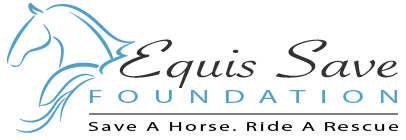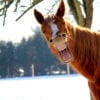Here is a health checklist for your horse. With the changing of the season, you need to evaluate the health of your rescue horse and the conditions of its environment. As summer has now faded to fall, you’ll want to make some health and management adjustments to head off any problems that may arise in winter. Here’s a handy checklist our team at Equis Save Foundation has put together for the fall season:
Pasture Conditions = More Hay
The first thing on the health checklist for your horse is to check the hay. As greenery conditions change significantly in fall, new grass growth dwindles while existing supplies get chewed up. Horses tend to indulge in vegetation they might otherwise ignore, which leads to poisonings. Introduce more hay to the barn long before the pasture is barren of grazing grass.
Acclimate Diet to Exercise
Fall and inclement weather may reduce the riding season, cutting down on exercise. Therefore, you need to pay attention to the calories your horse is consuming. If the horse continues to feed as it did during the buffet of spring and summer, weight gain is inevitable. This is on the health checklist for your horse because weight gain can cause issues.
Get Caught Up on Routine Maintenance
With decreased riding activity, fall is a great time to get caught up on routine health care tasks that were overlooked during the summer. Sheath cleaning and teeth maintenance are essential before winter comes. It’s also an advantageous time to give a shod horse some free time without horseshoes.
Look for Increased Parasite Activity
The prevalence of infective parasite larvae will spike in the fall. The next thing on the health checklist for your horse is to keep an eye out for parasites. In addition to the dangers of poisoning from eating toxic plants, your horse may graze on grass in close proximity to manure. Guess where parasites love to hang out? Now is the time to ask your veterinarian about the regularity of your deworming schedule.
Beware of Laminitis
If your rescue horse is insulin-resistant, the risk of laminitis goes through the roof in the fall. Older horses with early Cushing’s disease are also in the crosshairs. There is a proven seasonal increase of the hormone ACTH in all horses from mid-August through November. Elevated cortisol puts vulnerable horses at high risk for fall laminitis.
Have You Done Your Housekeeping?
With winter around the corner, the time is now to evaluate your property with the rescue horse in mind. Repairs ignored now will become full blown disasters once winter is in full swing. Anything that looks like it needs fixing should be addressed before the freezing chill of winter turns your pasture to icy tundra.
Expand Your Checklist
Hopefully this health checklist for your horse helps you prepare for winter. Did you encounter problems last winter? This is the time to refresh your memory about mistakes you made and things you could improve. You probably had some good ideas that got put on the back burner until spring, and of course, forgotten about once the weather turned warm again. Your expanded checklist is theoretically never-ending.
Find more information on horse care on the Equis Save Blog!






